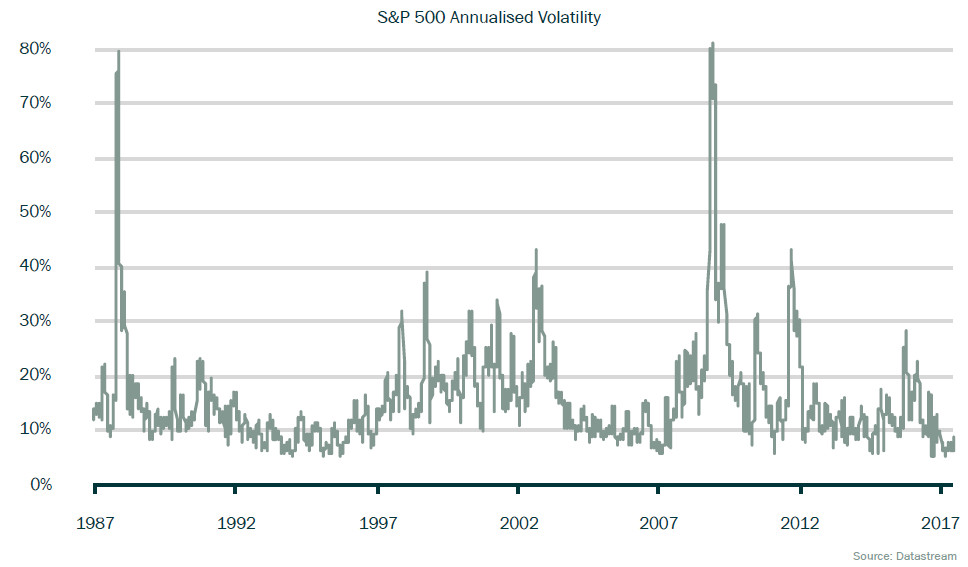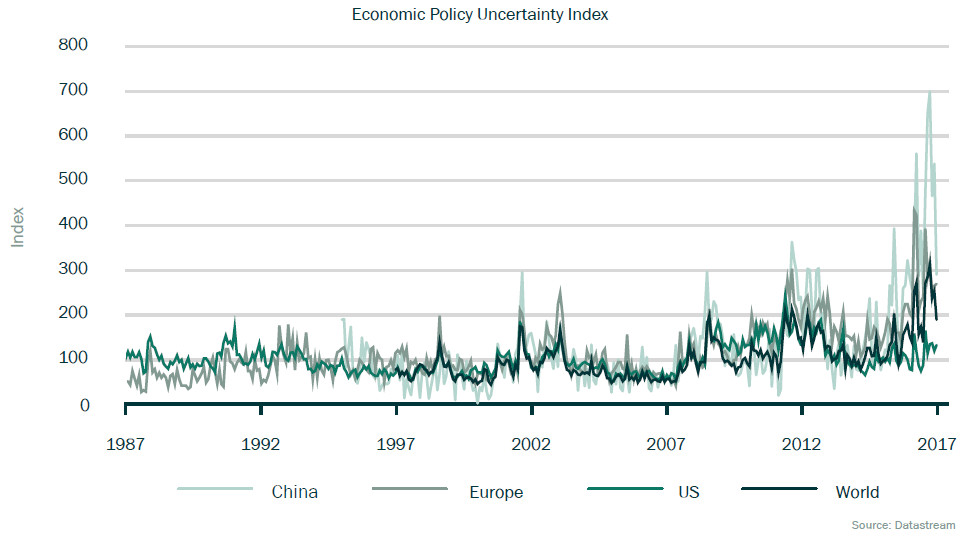The environment of heightened uncertainty lies in contrast with apparent investor complacency, as judged by current market pricing. While the current investment environment is one that features considerable uncertainty, valuations in equities and bond markets are high. This implies expected returns may be inadequate to compensate for the uncertainty in the environment. GIC’s investment response has been to build a resilient and diversified portfolio to ensure that capital and returns can be best protected over the long term.
Risk and uncertainty
Risk is fundamental to investing. Poorly managed, risk can lead to adverse investment outcomes that ultimately result in failure to achieve investment objectives. But in dealing with risk today, investors are confronted with profound questions. Statistical measures of volatility, the conventional definition of risk, are extraordinarily low by historical standards. And yet, global political, economic and social developments signify a highly uncertain, unpredictable future. How should investors measure and manage risk and uncertainty in this environment? How can they achieve their investment objectives in an age of uncertainty?
It was Frank Knight, an American economist, who made the distinction between risk and uncertainty. Knight defined risk as applying to situations where, while the outcome is unknown, the likelihood (or probability) of possible outcomes can be quantified through standard statistical computations such as averages, standard deviation (or volatility) and correlations. Uncertainty, on the other hand, as conceptualised by Knight, was drastically different from risk. For him, uncertainty applied to cases where the outcomes were unknowable. Correspondingly, their probabilities cannot be computed.
Knight’s distinction between risk and uncertainty is particularly germane for investors today. Recent history covers some notable market situations where the reliance on standard measures of risk has fallen short.
An example of the limitations of standard risk analysis was the Global Financial Crisis (GFC). During the run-up to the GFC, quantitative risk models were typically used to price complicated financial securities. While seemingly sophisticated, these mathematical models failed to capture important correlations, and possible changes in such correlations. The outcome was that risk was seriously mispriced, resulting in defaults and losses. For example, the Chief Financial Officer at a major investment bank said in August 2007 that the losses suffered on one of their hedge funds were “25-standard deviation moves, several days in a row” . Based on standard distributions of risk, such moves in prices should only have occurred about once every 13 billion years. The fact that such price moves were observed was a sign that the models of risk had grossly underestimated the true degree of risk and its price impact.
The current market environment features abundant liquidity and low yields, which have contributed to the suppression of volatility across equity markets (Figure 1). This does not mean that uncertainty has been removed from the environment.

Figure 1: Expected Volatility of the S&P 500 is low
An uncertain environment
Developments such as Brexit, the US Presidential elections and heightened geopolitical tensions belie the sanguine view of market risk as conveyed by standard risk measures. In addition, there is great uncertainty in how technology is altering labour markets, driving income inequality and fueling the rise of populism, for instance. These potentially disruptive forces in the market place further suggest that conventional risk measures may not adequately guide investors. The concept of uncertainty needs to be taken into account. For example, a policy uncertainty index developed by Baker, Bloom and Davis indicates that such uncertainty is the highest over the last 30 years (Figure 2).

Figure 2: Increased Economic Policy Uncertainty
Past patterns will likely not be a useful guide. Trends related to populism, geopolitics, disruptive technology, even monetary policy, have raised fundamental questions about the future macroeconomic and investment environment. The normalisation of monetary policy from extraordinary levels of policy accommodation similarly has no historical precedent. Standard risk models given these uncertainties are thus insufficient.
In theory, higher risk goes hand in hand with higher expected returns as investors expect to be compensated more for investing in an asset for which the payoffs are less definite. For example, investors expect to earn a “risk premium” or excess return by owning equities over bonds.
The outlook for risk assets at the current juncture, however, does not only feature low returns, but also heightened uncertainty, amidst low measured volatility. The combination of low returns with high uncertainty is particularly challenging for investing.
How should we respond to such an environment?
A key part of GIC’s strategy to deal with an environment that features not only low returns, but also high uncertainty, is to ensure that our portfolio remains robust across a range of plausible scenarios. Scenario analysis embraces the inherent uncertainty by considering alternative environments to “stress test” the performance of the portfolio. Examples of how we deal with uncertainty through the use of scenarios are highlighted in “Preparing For A Low-Yield Environment”, where we assessed how global markets would perform in “back to normal” and “stagnation” scenarios. These scenario analyses are factored into our ongoing efforts to construct a robust portfolio.
The GIC Portfolio is diversified across multiple dimensions, kept within the overall risk tolerance thresholds, and has an asset mix that enables it to harvest risk premiums over the long run. It is important that we keep to our discipline of long-term value investing and reduce exposure when the risk-reward trade-off is less favourable over the long term. At its heart, this approach embodies one of our five investment principles — “Prepare, don’t Predict”.
Behavioural issues are also important when dealing with an environment of heightened uncertainty amidst low volatility. Experience has taught us that a low-volatility environment is not to be confused with a low-risk environment. Indeed, it is precisely this environment that tends to lead to excessive risk-taking behavior that can in turn result in mispricing of assets, according to the Financial Instability Hypothesis of late US economist Hyman Minsky. Managing investment risk goes beyond relying on standard measures of volatility. It requires an emphasis on assessing uncertainty, particularly in the current environment. Strategies of scenario analysis, diversification and guarding against complacency due to the phenomenon of low-volatility are important.







